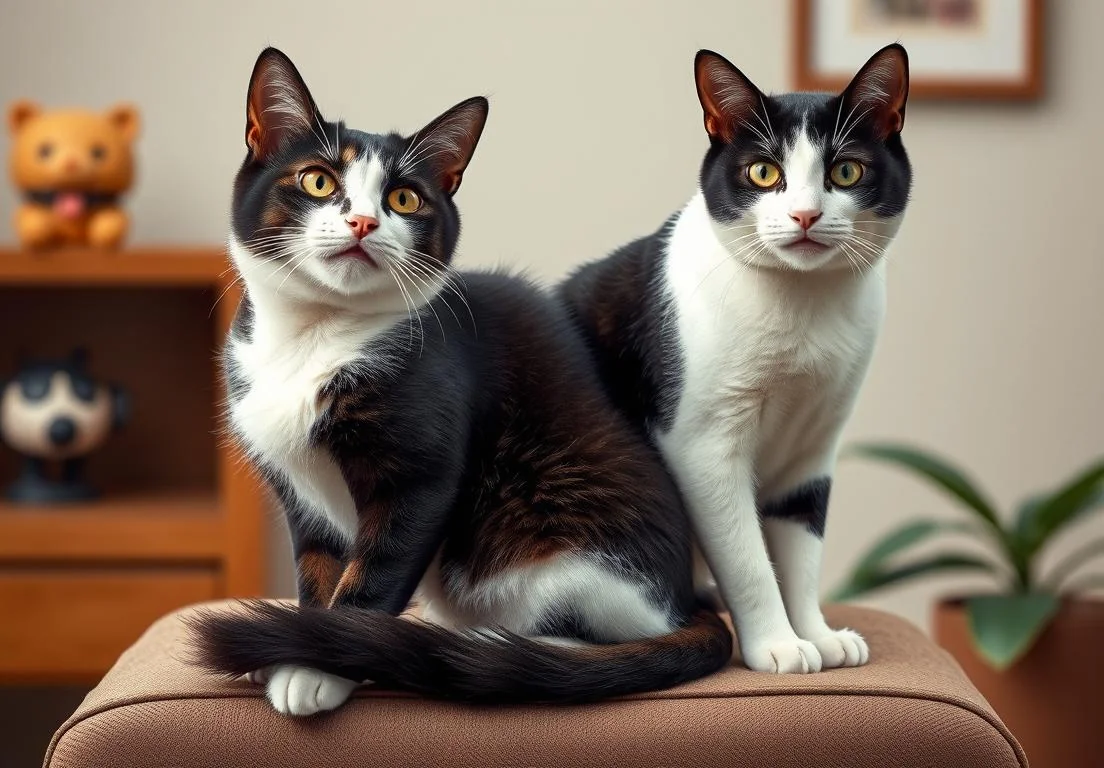Have you ever noticed how cats seem to claim everything in their vicinity as their personal domain? From your laptop to a freshly folded laundry pile, no surface is too small or insignificant for a cat’s royal backside.
Cats sit on things because they instinctively want to mark their territory and seek comfort. By choosing what to sit on, they assert dominance over their environment while also finding warmth and security. There’s a lot more to this curious behavior, though, and uncovering those layers reveals just how fascinating our feline friends really are.

Why Do Cats Claim Your Laptop?
There’s a good reason your cat thinks your laptop is their personal throne. The warmth radiating from your device is especially appealing; laptops can provide a cozy spot that mirrors a sunny windowsill, making it an instant favorite during those chilly days.
Beyond warmth, the raised surface of a laptop offers a vantage point. Cats are natural climbers and prefer to survey their territory from a height. Sitting on your laptop not only keeps them close to you but also allows them to watch you — like a furry little overlord monitoring their realm.
Interestingly, this behavior isn’t just about comfort. Many cats are intrigued by your attention to the laptop. It’s a classic case of wanting to be part of the action; they see you engaged and, in their eyes, must join in. This can create a classic standoff between your typing and their lounging, with your cat always winning out, of course.
What Makes Your Lap So Appealing?
Your lap is more than just a cozy oasis; it represents safety and trust for your feline friend. When a cat chooses your lap to curl up in, it’s a heartfelt sign that they consider you a safe haven. The steady rhythm of your heartbeat and warmth from your body create a comforting atmosphere, akin to a nest for them.
The act of sitting on your lap also establishes a strong bond. Cats often seek your company during moments of vulnerability, especially when they are tired or slightly anxious. This behavior isn’t just random — it signifies deep emotional ties. They feel secure enough to let their guard down in your presence.
Feline anatomy also plays a role. Cats have unique body warmth and purring can resonate soothingly, creating a blissful environment where they feel relaxed. The physical contact strengthens their sense of belonging, and their instinct is to stay close to those they trust. So next time your cat plops down on your lap, it’s really all about affection and safety, not just a prime resting spot.
Is It About Territory?
Cats are natural territorial creatures, and their habit of sitting on things might just be a way to stake their claim. When your cat plops down on your favorite sweater, it’s not just seeking warmth or comfort; it’s asserting ownership over that space. This instinctive behavior harkens back to their wild ancestors, who established territory to secure resources like food and shelter.
Every time your feline friend chooses a spot, they’re marking their territory, even if unconsciously. Sitting on your belongings can be seen as a statement—”This is mine.” It gives them a sense of security and control in their environment. While it might seem quirky to us, it’s a fundamental aspect of how cats operate. So next time your cat settles in on your laptop, they’re likely communicating, “I’m the boss here.”
Consider that in multi-pet households, these territorial behaviors can become more noticeable. Cats might sit on higher surfaces to assert dominance or occupy the choice spots your other pets might want to claim. Recognizing this helps in understanding their communication and temperament better.
How Does Scent Play a Role?
Cats also have a unique way of marking their territory through scent. They have special glands in their cheeks and paws that release pheromones, which are vital for social signaling. When a cat sits on an object, it’s often transferring their scent onto it, reinforcing their ownership.
By sitting on your belongings, they’re not just keeping warm; they’re effectively saying, “This is mine, and I want you to know it.” This scent-marking serves multiple purposes:
- Ignoring competition: When other pets or cats enter their territory, the scent acts as a deterrent.
- Familiarity: It provides comfort to the cat—scent-marked items reflect a safe space in their environment.
- Communication: It tells others that they’ve claimed that area, making it clear they’re in charge.
Interestingly, this behavior can vary depending on the individual cat. Some might love to sit on your lap or your belongings as a way to be close to you, while others may prefer to claim objects at random. Understanding these nuances can help in nurturing a peaceful coexistence and providing a comfy, secure home for your furry friend.
Are They Seeking Attention?
Cats are quite the savvy communicators. When they plop down on something, it’s not just because they like it—it could be their way of saying, “Hey, look at me!” Sitting on your laptop, your book, or even your lap can signal that they want your focus. This behavior often stems from a hierarchical instinct; they want to mark their territory by claiming whatever you’re using at the moment. Think of it as a feline way to assert dominance in a playful, attention-seeking manner.
In some cases, they leverage this sitting habit to nudge you for affection or a little playtime. If you notice your cat making a habit of this, they might be trying to tap into your attention resources. You can respond halfway—give them a scratch or a quick play session on the side to keep the peace without fully giving in to the interruption.
What About Comfort and Safety?
Resting in a cozy spot is more than just a luxury for cats; it’s crucial for their sense of security. They tend to prefer elevated surfaces or confined spaces, which are reminiscent of how their wild ancestors operated. Being high up can give them a clear view of their surroundings, making them feel safe from potential threats.
Moreover, soft and warm places are inherently comforting. Cats have a finely-tuned sense for seeking out warmth, often curling up on your warm laundry or the sunny patch on the floor. This behavior is instinctively linked to survival—finding warmer spots helps regulate their body temperature.
You might also notice that your cat gravitates toward your personal items, like bags or clothing. These smells carry your scent, which they associate with safety and warmth. Here’s a quick breakdown of their preferences:
- Height: Cats love to observe from above, feeling more secure.
- Warmth: They seek out warm spots; think sunny windowsills or laundry fresh from the dryer.
- Your scent: Personal items provide comfort, linking them to you.
By understanding these motivations, you can create a more inviting environment that caters to your cat’s preferences while maintaining your personal space!
Do Different Breeds Behave Differently?
Different cat breeds often have unique personalities and habits that influence their sitting behaviors. For instance, Siamese cats are known for their playful, social nature. You’ll often find them claiming your lap or the nearest chair, as they crave attention and warmth. In contrast, Persians, with their laid-back demeanor, prefer to perch atop plush surfaces where they can oversee their kingdom in comfort.
Maine Coons exhibit curiosity and intelligence, often opting for high vantage points. They might stake their claim on shelves or countertops. On the other hand, Bengals, known for their lively and energetic traits, may choose to sit on your things as a playful assertion of dominance.
Each breed has its quirks, influenced by their genetic makeup and historical roles in human homes. Understanding these traits can deepen your appreciation for why your cat seems to act like it owns every cushion or box in sight.
What Interesting Facts Do We Know?
Cats possess some fascinating traits when it comes to their sitting habits. For starters, they have scent glands in their paws that allow them to mark their territory. By sitting on items, they not only claim ownership but also leave their scent, a behavior inherited from their wild ancestors.
Research suggests that cats are naturally drawn to elevated spots, as it provides them with a sense of safety and control over their environment. This is why you’ll find your feline friend lounging on top of the fridge or a bookshelf. It’s an instinctual behavior rooted in their biology.
Additionally, a 2021 study from the University of Cambridge found that cats often choose to sit on items that smell like their owners, indicating that they seek comfort and security in familiar scents. So, the next time your cat settles on your laptop or that pile of laundry, remember—they’re just marking their territory, seeking safety, and enjoying the cozy scent of home.
How Can You Redirect This Behavior?
Cats thrive on a sense of ownership and territoriality, leading them to claim your belongings as their own. To help them find more appropriate resting spots without sacrificing their comfort, consider these practical strategies.
First, create designated spaces for your cat. Setting up cozy areas with soft bedding or blankets in quiet corners can encourage them to use these instead of your laptop or laundry. Cats love heights, so a cat tree or shelves can also provide appealing spots.
Next, use cat pheromones to make certain areas more inviting. Spraying a relaxing pheromone product around your cat’s designated sleeping areas can encourage them to settle there.
Consider positive reinforcement. When your cat chooses the right spot, reward them with a treat or gentle praise. This makes them associate their choice with something pleasant.
Another tip is to remove temptation. If your cat keeps gravitating toward a particular spot, try moving less cat-friendly items, like small decorative objects, to prevent them from claiming these spaces.
Lastly, redirect with toys. Use playful distractions, like a feather wand or a laser pointer, to draw your cat’s attention away from inappropriate areas. Playtime can help reinforce their natural instincts and keep them engaged.
By implementing these strategies, you can ensure your cat feels secure and comfortable while keeping your belongings intact.
Alex, a passionate animal lover, has experience in training and understanding animal behavior. As a proud pet parent to two dogs and three cats, he founded AnimalReport.net to share insights from animal experts and expand his knowledge of the animal kingdom.




